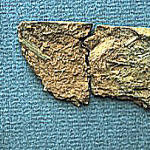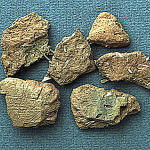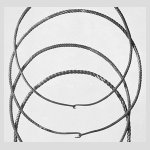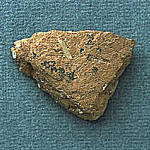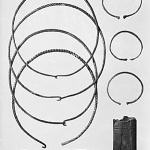

Home
Area
Vätsäri
Övre Pasvik
Pasvik Zapovednik
Nature
Geology
Climate
Water system
Flora
Fauna
Culture
Population
Religion
Sources of livelihood
Old ways of life
Time of industrialism
History
Stone Age
Early Metal Age
Late Metal Age
Middle Ages
Towards modern times
Timeline
Cooperation
Nature monitoring
Nature tourism
Publications
Contacts
Visit Pasvik-Inari
Guidelines
Regulations
News
Links
The Early Metal Age
New raw materials appear in the northern excavation material
The Northern Early Metal Age (ca. 2000 BC - AD 300) refers to the Bronze Age and Early Iron Age in Fennoscandia. The period is characterised by more intensive networks of hunter-gatherers which can be seen in the use of various, wide-spread tools. Also the differences between inland and coast settlement diminished. The making of pottery became more widespread, and more local variations can be seen in the decoration of vessels. Also a new innovation spread from the south - the use of crushed asbestos fibres for the mixture of clay mass.
In the Early Metal Age, most of the tools were still made of stone and organic materials. The main artefact type of this period is a wide-pointed arrowhead made of flint, quartz or quartzite. It is possible that along with these arrowheads a new type of bow also spread to Pasvik-Inari area but it cannot be proven because of the lack of evidence.
Axes, bracelets and neck-rings made of bronze
Few archaeological finds made of copper or bronze are found in the north. Most of these metal tools have been made elsewhere outside the area and came to the Pasvik-Inari area by trade. The earliest metal artefact found in the Pasvik-Inari area is the copper/bronze dagger or spearhead found at Karlebotn in Norway. Fragments of melting-pots used for casting of these points have also been found from the mouth of Pasvik River.
The strong East European contacts can be seen in the northern archaeological material around 900-600 BC by the spreading of the so-called bronze tube axes. Additionally, contacts with the central Swedish societies can be seen in the spreading of bronze bracelets and twisted neck-rings. A couple of caches dated to this period have been found in the Pasvik-Inari area. The Lusmasaari Island cache in Lake Inari contained 4 neck-rings, 3 bracelets, a piece of bronze plate and an eastern-type tube axe. A metal object, probably a bronze razor was found in the Grense Jakobselv cache in Norway. The item was later on lost. These places are situated along the trade route which led from the Gulf of Bothnia along the rivers Kemi and Kitinen to Lake Inari and from there onwards to the Arctic Ocean.
The Emergence of iron tools
North Fennoscandian societies became familiar with iron metallurgy around 600 BC, but there are no signs of iron objects dated so early in the Pasvik-Inari area. Instead, a new type of pottery called Kjelmøy (a settlement site in South Varanger, Norway) appeared in the settlement material in a vast area from Ruija and Kola Peninsula to Jämtland in Sweden. Asbestos was still used as a mixture for the clay mass, and alternatively also mussel shells were used in Varanger. The Kjelmøy vessels were produced by new method of extending the clay over a log model.
The northernmost smelteries from Kemijärvi and Rovaniemi in Finland produced simple, curved knives. Similar knives made from deer antler have also been found at the Kjelmøy site. This site is significant because its culture layers have surprisingly preserved numerous bone and antler tools, such as axes and chisels. The Early Metal Age in the north ends with the drastic change of material culture around AD 300 after which there are no traces of pottery making or iron metallurgy.
